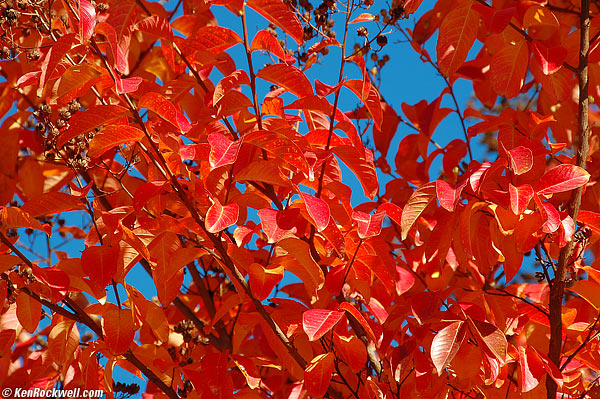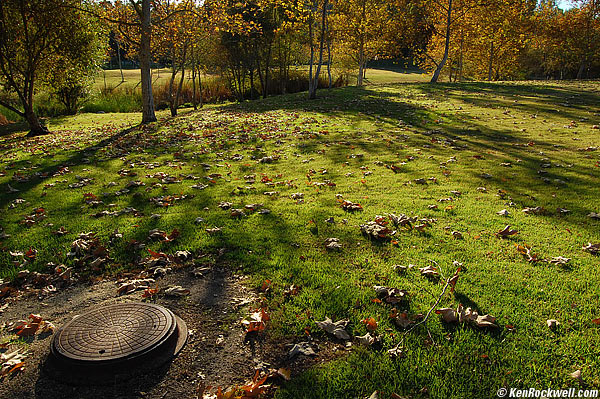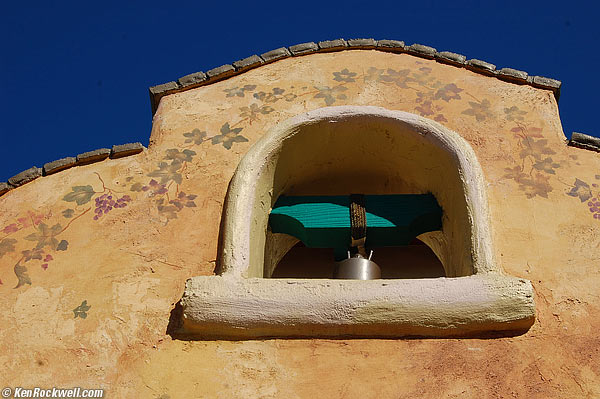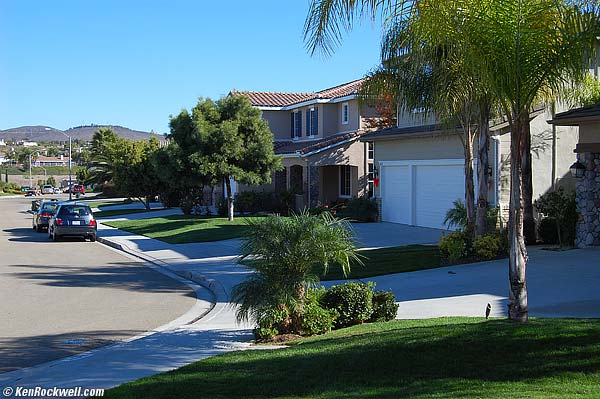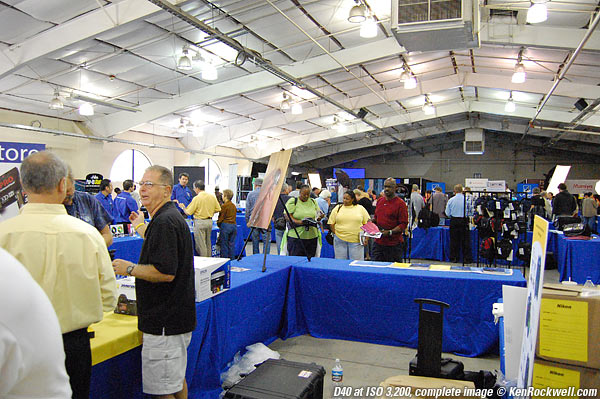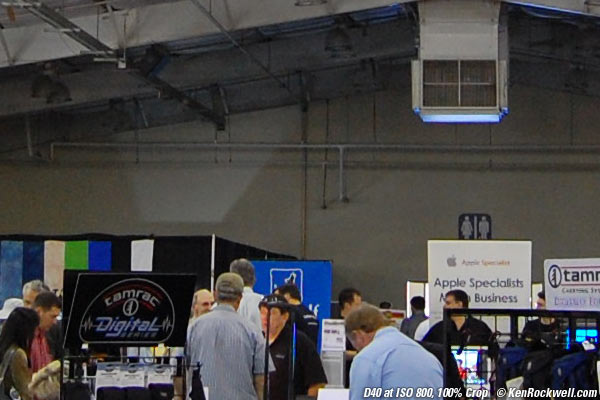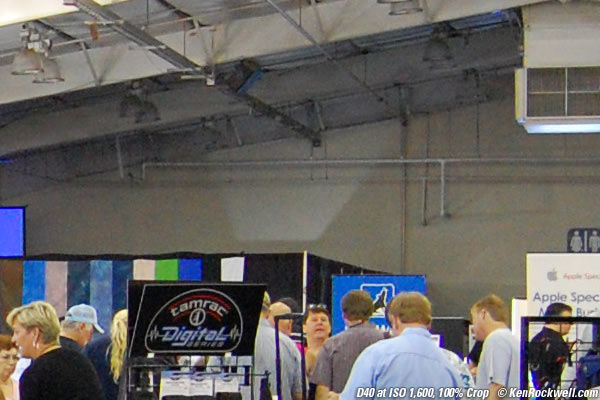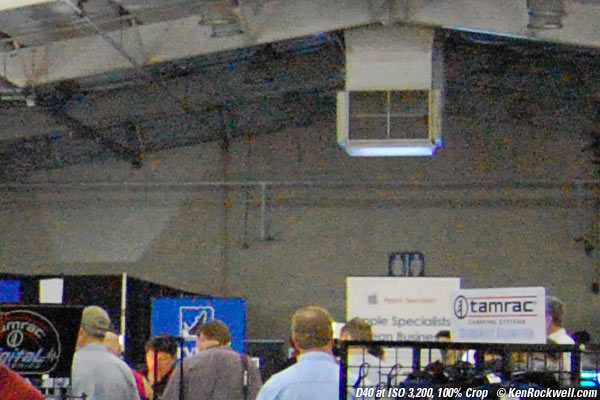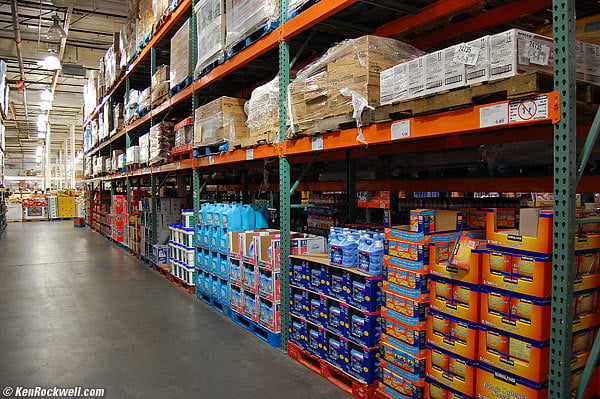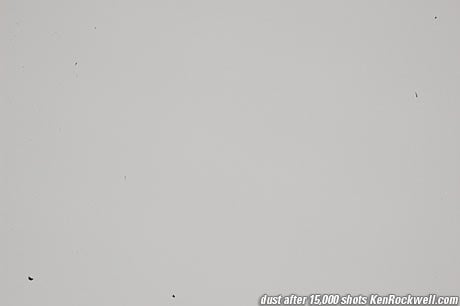|
I personally buy from Ritz, Adorama and Amazon. I can't vouch for any other ads.
|
Nikon
D40 Performance
© 2008 KenRockwell.com
Nikon D40 with new 18-55mm lens. enlarge
I bought mine here from Ritz. I'd have gotten it here or here just the same.
Top Introduction Specifications Performance Recommendations
Weight LCD Examples Color Exposure Lenses Power
Ease of Use Histograms Auto ISO High ISOs Data
Aliasing Printing More Examples Cold Macro Dust
Lens Performance: 18-55mm AF-S II
I love this thing as you read at the Introduction. Here are the details.
Weightless! back to Performance. back to top.
The first thing I noticed, and so did my non-photographer wife, is that it's so light. We all thought it would be much heavier, but no! It must be made of air. It's like not having a camera with you at all. The light weight makes it a dream to carry around all day. I also find the D40 lets me get make great results hand-held at slow speeds, probably because it also has very, very little vibration as the shutter fires.
Fantastic Screen back to Performance. back to top.
The second obvious WOW! is the big, bright, sharp, contrasty and almost three-dimensional LCD screen. It looks the same regardless of the angle from which you view it. It's the same vivid, accurate screen as on my D80, which I think is the same thing as my D200.
I don't know about you, but I use my LCD all day to set exact exposure and white balance, and this LCD is just about as accurate and is as bright as my calibrated 30" Apple Cinema Display which cost me $2,500 earlier this year. Next week I hope to stick my color meter on it to see for sure.
It makes my Canon 5D look dim and pathetic by comparison. My D40's LCD is bright! It's almost blinding at night, a far cry from the dim Canon DSLR LCDs I've been staring at all week.
On the D40, what you see is what you get. The menus and images look awesome!
Great Shots back to Performance. back to top.
Image quality is great. It's the same as the D70/D50, but with a much bigger and better LCD on which to view them while shooting.
Color back to Performance. back to top.Here's a shot from December 6th, 2006:
Tree, D40, 18-200mm at 200mm, f/11 at 1/160, program -0.7 stops.
I have my secrets to getting these colors, which is looking for colorful things then snapping a picture. Other secrets are to set my D40 to + saturation, -0.7 exposure and auto everything else. Point and shoot! This is exactly what came from my D40, no cropping, no playing with colors or anything. Here's the 2MB camera-original JPG.
Here's a drive-by shot. Colors and exposure all exactly as the came from my D40 at my usual settings (+ Saturation, -0.7 exposure, Auto -3 WB, basic JPG, everything else on default). I fixed the drive-by perspective in Photoshop CS2's lens distortion filter.
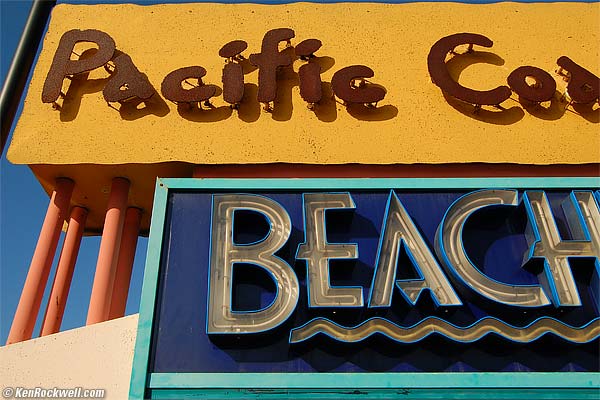
Solana Beach, California, 2PM. D40, 18-55-II at 20mm, f/10 @ 1/400
Exposure back to Performance. back to top.
No surprises: it has the meter and calibration of the D80. This means it's Hell bent for shadows, or that it ignores highlights and exposes for the darkest object. I leave my exposure compensation set at -0.7 most of the time, although for flat subjects I may set it as high as 0.0 and for contrasty subjects may need to go to -1.7.
Just like all the other current Nikons, flash exposure and fill is dead-nuts on. Here's a grab shot of the wife and dog:
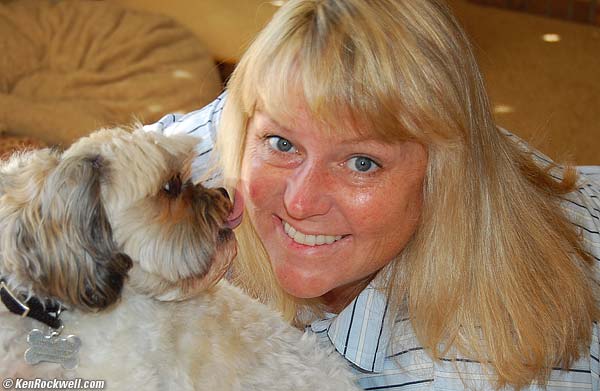
Dog Licking Wife, D40, built in flash, 18-55-II at 42mm, f/4.2 @ 1/60.
I love how Nikons nail the exact amount of fill flash the very first time. This also made at my suggested default of -0.7 stops. See how her face just looks right along with the background? On my Canons she'd either be blown out or way too dark and I'd have to try a couple of times until it looked right. You never get a second chance with these shots, since the wife has zero tolerance for picture taking. Note motion of dog tongue, simultaneously frozen by flash and blurred during ambient exposure.
Here's one from last weekend:
Somewhere in Orange County, California (click for 900 KB original)
I made this shot with my 18-55mm kit lens yesterday. It looks great! Of course the depth of field is limited if you're looking at the top corners of the original. My sharpness tests with the 18-55 look great in the corners, but are too boring to post.)
After 15,000 shots and 15 months of use, my D40 still cranks them out:
Don Jose's, 10 February 2008. Shot on D40 and 18-55mm kit lens. original file.
See any dust in this shot? I don't, but if you do, see how I cleaned my sensor below.
Lens Compatibility back to Performance. back to top.
Take a Picture |
Manual Focus |
Metering and Auto Exposure |
Auto Focus |
|
Yes |
Yes |
Yes |
Yes |
|
Yes |
Yes |
Yes |
NO |
|
Yes |
Yes |
Yes |
NO |
|
Yes |
Yes |
NO |
NO |
|
Yes |
Yes |
NO |
NO |
The D40 can make great photos even with old manual focus lenses from 1959, but you'll have to guess at exposure and focus them by hand. (Of course the superwides from the 1960s that receded into the camera and required mirror lockup to mount won't attach.)
I prefer to have autofocus and exposure metering without having to guess looking at the LCD shot-to-shot, so I only use the very latest AF-S autofocus lenses. Even regular, non-AF-S AF lenses won't autofocus: you'll have to turn the focus ring by hand and look for the "in focus" dot in the finder.
Only the newest AF-S lenses will autofocus. Older AF lenses will need manual focusing. The important letters are "AF-S" (or AF-I which were on the very expensive pro lenses of the early 1990s, like my 400mm f/2.8). This means your lens has the newest circuitry and motors to focus properly.
This isn't that big a deal. The included lens replaces my old lenses, and my recent Nikon lenses are all AF-S. Old film lenses you think may want to use are probably not as useful as you'd think.
Older AF lenses which are not AF-S or AF-I won't autofocus. You'll have to focus them by hand and look for the green "focus OK" dot on the lower left of the D40's viewfinder. Forget this with anything other than wide angle lenses, otherwise you'll go crazy focusing them.
DX, G and D designations have nothing to do with focusing. The letters which certify a lens works perfectly on the D40 are either AF-S or AF-I, not to be confused with AI-S.
DX and non-DX lenses work equally well on the D40. G and non G lenses work equally well on the D40. I explain this alphabet soup at Nikon Nomenclature.
The 18-55mm II kit lens is great. Just like the previous 18-55mm, this little guy focuses well, is sharp, focuses way too close (great for close-ups) and is much easier to zoom precisely than many other lenses. Distortion is the same: average simple barrel distortion (4.5%) at 18mm, and no distortion at all at 55mm.
My D40 works perfectly with my Nikon 18-200mm VR, as expected, since the 18-200mm is AF-S.
It works perfectly with my 1990s 80-200mm f/2.8 AF-S. Autofocus is fast and dead-on at f/2.8.
I tried my 10.5mm fisheye, not AF-S, and it works great. Of course that's an older-style AF (not AF-S) lens so I had to focus manually, which is a non-issue with a fisheye. All the metering and exposure modes work perfectly.
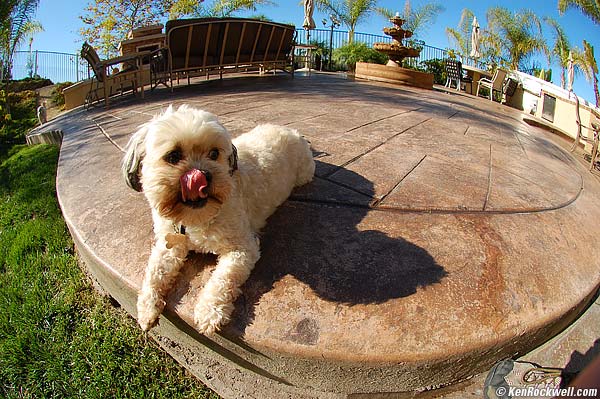
Cute Little Dog. D40, 10.5mm fisheye, f/9 @ 1/320, 1 foot away, manual focus.
Ditto for use with my 105mm AF Macro. It works great, except there's no autofocus. I usually focus my macro shots manually anyway. For instance, I made the shots of the Canon 17-40mm lens with my D40 and 105 macro, manual focus. Everything else, like metering and exposure, work perfectly.
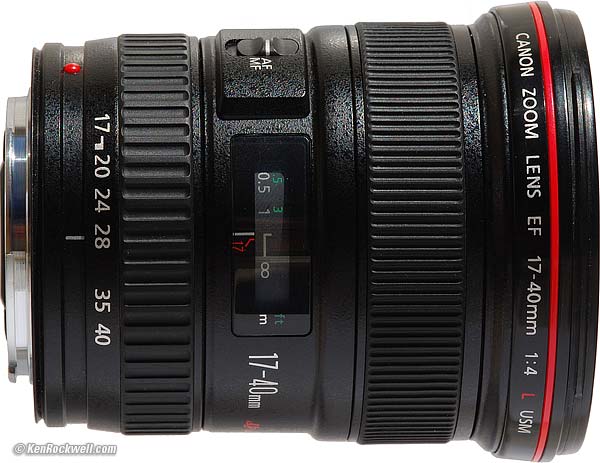
Canon 17-40mm. Shot with Nikon D40 and Nikon 105mm lens, f/16 @ 1/250, ISO 200.
Forget manual focus lenses (AI, AI-S, etc.). The D40's meter doesn't work with them, so you'll have to guess at exposure. That's not much fun, except if you're in a studio with constant light.
My D40 works perfectly with the older professional AF-I lenses like my 400mm f/2.8.
Heaven help you if you've wasted money on third-party lenses. Many of them won't autofocus with the D40. You'll need Sigma's HSM lenses. Nothing from Tokina autofocuses on a D40, and I don't think anything from Tamron does either.
I've been buying lenses for enough decades to see Nikon trump the bottom-feeders before. Nikon always puts secret new features in their current lenses to help them work with future secret camera innovations. Nikon changes lanes and leaves the third-parties in the dirt. Even my Nikon AF lenses from the 1980s encode focal lengths in my D40's EXIF data. My 1970's AI lenses have mechanical focal length and falloff data encoding for use with never-designed cameras which were going to read that data mechanically!
Third parties never have any idea what's up Nikon's sleeves. Third parties have no authorization from Nikon to do anything and Nikon expressly cautions against using third-party lenses and flash in the instruction manuals.
Power and Battery Life back to Performance. back to top.
Battery life is great. The meter is mediocre, with only three segments capable of displaying four levels, but with the battery life of Methuselah, it's no problem.
It read full (three segments) for my first 850 shots.
After those 850 shots I sat for an hour and played with the menus. After that it read two segments.
At 980 shots it dropped to 1 segment and the low battery icon appeared in the finder.
At 1,192 shots it died. The last segment sat blinking, and so did the low battery icon in the finder.
It dies in an interesting way. Most cameras just die. The D40 half dies and then messes with you! I didn't know I finally killed it. I was shooting away, and some, but not all, of the menu options became grayed out. I looked around, and discovered the battery gauge, which I was trying to kill, was blinking.
On another charge I got 500 shots at the 2/3 mark, and 750 at the 1/3 mark.
The D40 has an interesting new feature. If you see a "?" on the lower right of the finder, press the "?" button on the rear. It will tell you what's going on. I did, and my D40 told me that the shutter was locked due to a low battery. Unlike other cameras, I could still play back images!
Trying to break something, I plugged my D40 into my Mac to see if I could download the last couple of hundred shots I had just made before it really shut off and corrupted my data. No problem! I was able to download everything, and all the time the blinking battery icon stayed blinking on the rear LCD. After that I put it on the charger.
This is great: I made all those shots and was able to download them. That's how I do my battery tests: I also have to be able to download, not just shoot, all the shots. Downloading is fast: 340 MB/ minute.
The charger has a cord, not a more compact folding plug like the Canons.
The battery recharges from totally dead in about an hour and and twenty minutes. The only easy way to exhaust the battery is to forget to disconnect the D40 from your computer, in which case it will not automatically turn off and stays on until dead.
I see no need for a spare battery. I'll never be able to run it down in a day.
Easy to Use back to Performance. back to top.
My D40 is easy and fast to use. I figured out how to set the clock and add my contact information and copyright notice to every image automatically and have never opened the manual. Actually, I've learned everything you read here I still haven't opened the manual.
Unlike compact cameras, there's no delay when pressing the shutter.
Someone wrote me concerned that some non-photographic tech site complained about a long shutter delay. I didn't read that review, however non-photographer techies often don't know how to use cameras correctly and complain when it's pilot error. Mine doesn't have any delay. Of course the shutter may lock if the flash has to recharge from a very long distance shot (it's usually immediate, and if this is a problem, use an external flash), and of course you need to know to hold the shutter halfway first to let the D40 grab focus, then recompose, and then the shutter goes off the instant you press it the rest of the way. People who try to mash a shutter all the way down at once may see these issues, but you're not supposed to do that. That's the best way to get blurry, poorly composed photos.
Unlike my Canons, I don't have to hit the Play button to zoom or see other shots after I make a shot. On my Canon 5D I have to hit the play button to zoom a photo I just made, or to compare it to others. This D40 is great.
The D40 will show very well in a camera store. It has a free photography course built in with examples! Your salesman will wow you showing, on the D40 itself, what happens as you change exposure compensation to a shot permanently embedded in the D40 and how the camera has examples permanently burned into it of what the various flash modes do. I've never seen anything like it, and the examples look great.
The built-in photo class is nice, but I think it's more of a way for Nikon to wow buyers on the sales floor than something that will help anyone while actually out shooting. I found it was hard for me to try to navigate around all that junk to get to what I needed.
I fear the very people this is supposed to help may just get lost, since watching someone else show you is fun, but when you try to do it yourself, good luck! It's like classes I've taken watching someone else operate a computer. Good luck trying to duplicate what they did after class is over on your own computer!
After my first day, I learned to use the MENU button to get to the Shooting Menu to get to the critical ISO, QUAL, WB and other shot-to-shot adjustments. Forget the "Info" buttons, which are to call up what used to be shown on the top LCDs of other cameras. My Canon Rebel XTi does this more elegantly, since it has an eye-detector to turn the LCD on and off as you put the XTi to your eye. My D40 isn't this smart, but no big deal.
TRICK: The "My Menu" options really work! Instead of having to click through three pages of custom settings, you can use the My Menu selection to turn off the settings you don't use so the ones you do use take up only one page. Great news! Here's how to do it:
1.) Wrench (Setup Menu): Set CSM/Setup Menu to FULL. (Default is Simple.)
2.) Make all your settings for everything, like remember to set file numbering to Continue and to add an Image Comment, which embeds your personal info into every file.
3.) Now that you've set them all, you can turn them off and they still apply!
4.) Return to Wrench (Setup Menu): Set CSM/Setup Menu to My Menu.
5.) Go deeper, ands turn off all the items you don't use on a daily basis. The goal is to get them down to a single page.
I only have Format and Time active in my setup menu, making it easy to Format. Having only eight things in my Custom Setting menu makes it easy to change the Auto WB setting as I change lenses.
It's easy when you want to do something deeper in the menus again. Just go to the wrench (Setup) and reset CSM/Setup Menu to FULL. Change what you need, and then set it back to My Menu when done. Whatever you set before returns!
Histograms and Color Balance Tricks
back to Performance. back to top.
I discovered a trick to get a real RGB color histogram (not the useless single one you get by clicking the up or down arrows). After making a shot, press OK which brings up the gimmick menu. Click down to FILTER EFFECTS, then press OK, click down to COLOR BALANCE, and hit OK. AHA!! RGB Histogram!
The next time you need the RGB Histogram, and I use it almost every scene, you won't need to navigate to it. Once you've used it the first time, press OK exactly three times (slowly) and you're there. Hit Play to get back.
So what is this color balance tool? It's actually useful! It calls up a better control panel than Photoshop's color balance tool, which dates from the 1980s. Nikon's tool reminds me of what we have on million-dollar color correction machines used in Hollywood telecine to color correct motion pictures.
The Nikon D40 shows three histograms (reminiscent of Tektronix' WFM700 waveform monitors) and the D40's nav key becomes the color correction track ball. Click it left and right to alter blue-red, and up down for magenta - green.
If you have something neutral, watch the waveforms, oops, histograms, until they are about equal. Left - right on the nav key slides the red and blue in opposite directions, and green - magenta slides the red and blue equally left or right. The green stays put.
When you see what you want, hit OK and the D40 saves a new file, called CSC_xxxx.jpg (not DSC_xxxx.jpg) incremented one up from the most recent shot's number, but saved with the original capture date. These additional files (the originals are left alone) will sort correctly if you sort them by capture date, which I do in iView. I'm unsure if a Windows file listing by file creation time will handle it. Mac finder listing by date modified won't, since the modify time will be later than the original. The Capture date EXIF field is unchanged, so by sorting by it puts my new files with the originals.
How does it work? Great! Here's a shot made in AUTO WB. Roll your mouse over to see after I corrected it. I love really warm. You can select any color you wish if this is too much for your taste. Unlike my Canon 5D, the LCD on my D40 is accurate enough to make meaningful adjustments.
Morning in the California Suburbs. (mouse over to see after.)
The new, corrected file saved was the same size as the original, and to Nikon's credit, I didn't see any technical degradation. (I didn't bother adding the originals here.) I normally would do this on my Mac in Photoshop, but sitting for an hour waiting for her to get her hair done I had time to learn this. Also to the D40's credit, I played for at least an hour making no new photos, so when my first charge lasted for over 1,000 shots, that's including all this fooling around.
My D40 is cooler than I prefer in Auto WB, so I now set it to AUTO -3, which I do in the menus.
Auto ISO back to Performance. back to top.
Auto ISO works great. When I shoot Canon DSLRs which lack this, I miss grab shots like this:
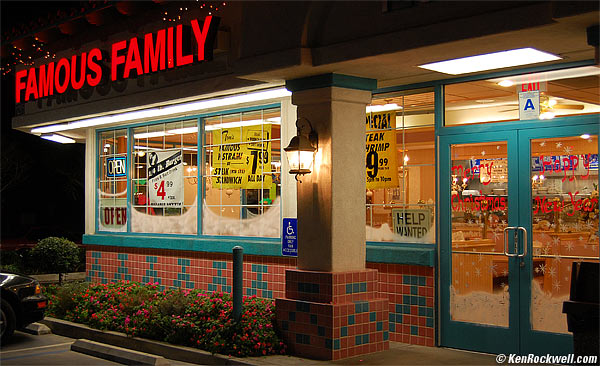
Grab shot on way back from dropping wifes ephemera in car.
D40, 18-55 kit lens @ 31mm, 1/30 @ f/4.5, Auto ISO at 320. Program auto, no exposure compensation, auto WB, auto everything, etc. "Auto ISO at 320" means that the D40 bumped the ISO to 320 (from 200) to ensure the shutter speed didn't drop below 1/30. When I'm dropping things back in the car for the wife I have no time to piddle, or I'm chastised. Auto ISO ensures that ISO is high enough to give sharp images, but no higher than necessary to ensure clean, noiseless ones.
The D40 adds a second kind of Auto ISO, which confused me since the D40 calls them the same thing in the menus. AUTO ISO in the Shooting (green camera) menu's ISO setting is completely different from the Auto ISO setting I always use in the Custom Setting (red pencil) #10 menu.
The Auto ISO setting in the shooting menu allows the D40 to choose the ISO based on the preset scene mode (sports, kids, etc.). This is why it's not available in the regular (P, S, A, and M) modes. I don't use the preset scene modes.
There is a trick to turning on Auto ISO in the usual P, S, A and M modes. You have to:
1.) Go into the Setup Menu and select FULL for CSM/Setup Menus. By default the D40 is in SIMPLE, which eliminates the next menu choices!
2.) Go into the Custom Setting Menu, turn AUTO ISO ON (CSM 10) and select any favorite parameters.
My Nikon D40 is so smart that if I shoot before the flash recycles, presuming I have Auto ISO activated, my D40 automatically pulls the ISO up to 1,600 (or as needed) to get the one frame where the flash doesn't fire. Wow: it shoots the whole sequence at ISO 200, and the one frame with a flash misfire due to shooting before it recycled shoots at ISO 1,600 as I wanted.
High ISOs back to Performance. back to top.
High ISOs look great. These snaps are from Nikon's demo back in November 2006. I'll have real examples from mine up later.
Every thing looks perfect through ISO 800.
Full image, Nikon D40 at ISO 3,200. (click for original)
As you can see, at normal sizes it looks great even at ISO 3,200. The next shots are blown up to 100% pixel-to-pixel on your screen, which is the same as making 20 x 30" prints.
D40, 100% Crop at ISO 800. (click for original)
ISO 800 from the D40 looks like ISO 100 from a point-and shoot. Here's the original JPG file direct from the D40 at ISO 800.
D40, 100% Crop at ISO 1,600. (click for original)
ISO 1,600 gets a very little bit noisier, still much better than a compact digital camera at ISO 200. I'd shoot ISO 1,600 on a D40 anytime I need it. Here's an original JPG file direct from the D40 at ISO 1,600.
100% Crop at ISO 3,200. Of course this lets you see things as you would on a 30" wide print! (click for original)
ISO 3,200 is noisy. It works great when you need it; you just don't want to shoot this way in daylight. Here's an original JPG file direct from the D40 at ISO 3,200.
Oddly, ISO 3,200 reads as ISO 1 in my copy of iView. This is copying and using the JPGs direct from the D40. I don't use Nikon software for anything, and if I downloaded using the Nikon software it may tweak the EXIF data to fix that.
Data back to Performance. back to top.
It downloads at 330 MB (480 large basic JPG shots) per minute with my 2 year old Lexar 1GB 32x SD card, which is fast. I can suck in a day's shooting in a few minutes, and a fast shoot in seconds.
It transfers 380MB (520 basic large JPG images) in a minute from my recent 2GB SanDisk Extreme III SD card.
Clock Setting and Accuracy back to Performance. back to top.
I figured out how to set the clock as soon as I turned on my D40 the first time. Easy.
It ran fast at a rate of about 27 seconds per month for the first month, and after three months it was running at an average of 47 seconds fast per month.
. It was two and one-half minutes fast on March 11th, 2007 when I set it to daylight time and was dead-on when set the day I got it on December 3rd, 2006.
It's trivial to change back and forth to and from daylight time. There are daylight time and time zone settings which don't affect the setting of the seconds. This normally would be important, but since my D40 keeps such awful time (I have mechanical watches which keep better time) `it's not that critical.
Aliasing (Moiré) back to Performance. back to top.
Yes, on some fine repeating patterns. The D50 and D70 also did this, as does my Canon 5D.
Printing back to Performance. back to top.
See also How to Get Great Prints.
I love Costco. We were out running around yesterday, I popped my card in their machine, and I had great 12 x 18" prints in my hand before we got home!
Hint: Costco's kiosks aren't for sorting out your good shots. The kiosks can't show you anymore than a tiny thumbnail on a dim, low-resolution screen, so I can't tell sharpness or exposure.
I used my D40 and it's stellar screen to select the ones I wanted, and marked them on paper. It's easy to do this on the D40: I sorted through 800 shots while sitting in the parking lot at Costco, with an impatient wife wanting to head in. It's easy to select through that many shots on Costco's kiosks if you know the file numbers you want in advance.
Costco, Local Photo Printing Capital. 800 kB original.
OK, you made me say Costco. Here's a grab shot as the wife went ahead. Yes, this is an excellent kit lens, and remember that it's with the lens wide open so the sides aren't supposed to be in focus. (AUTO ISO 720, f/3.5 @ 1/60, 18-55mm @ 18mm.) It still looks great, and Auto WB and Auto ISO worked perfectly. You easily can correct the distortion of the shelf support on the right in Photoshop :
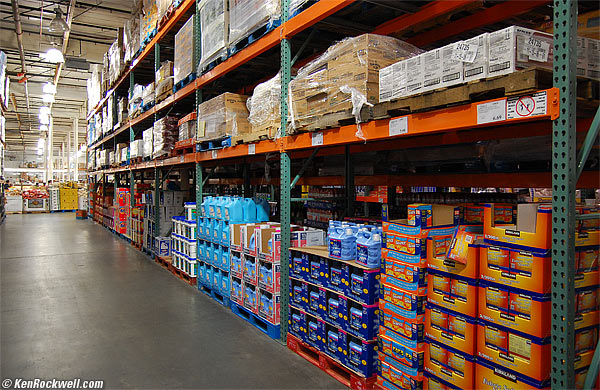
After correction in Photoshop CS2's lens distortion filter.
What's Missing: back to Performance. back to top.
No top LCD. You read everything off the rear LCD. Tap either <i> (info) button to light up the rear LCD with your settings. This is nice: now the exposure function knob is where I can flick it with the same hand I use to hold the D40, and I can see my settings from my shooting position. Top LCDs were vestiges from film cameras which had to put the knobs on top since the back had to open to hold the film.
No big deal, but if you want to check your focus area and exposure compensation settings before raising the D40 to your eyes, now you have to wake up the rear LCD, which takes a fraction of a second. I check my top LCD on my other Nikons instinctively before making grab shots, since it keeps the time the camera is raised to a minimum. I shoot from the hip by using the top LCD for my settings and never raise the camera to shoot. Now I have to wake up the rear LCD, which can alert people that I'm about to shoot.
The rest of these items are things most people don't understand. All the important stuff is in the D40. I haven't found, and suspect that there are no:
Won't autofocus with non-AF-S or non-AF-I lenses.
Viewfinder grid lines.
No depth-of-field preview button.
No ability for wireless control of the SB-600 or SB-800. You'd have to buy an additional SB-800 or SU-800 to do this from the D40. The D40's built-in flash does work in manual , so I can use it to trigger my professional studio strobes without buying anything else.
No flash exposure lock, critical to preventing people from blinking. To the defense of the D40, my usual blinking subjects didn't blink for the default mode of the D40 even though there is a strong and visible preflash, so better to have no problem than a way to work around it.
No LCD protector. No big deal, Canons don't have them either. Use a stick-on PDA screen protector if you worry.
No power interlock on the card door. Nikons don't do this while Canons turn off the power if you open the card door with the camera on to help prevent you from damaging a card pulling it out while the camera is writing to it.
No way to set the slowest speed in normal flash mode in P mode. It defaults to 1/60. I set mine down to 1/8 or 1/15 to get more ambient light on my other cameras, but I also get more blur.
Only 3 AF Points: So what? It still works great. The rear nav thumb switch works intuitively as the selector.
No AF / MF switch. You use the switch on your lens instead.
More Examples back to Performance. back to top.
Here are some shots from Friday night's dinner. It looks like my D40 also prefers a default setting of -0.7 exposure compensation, with which the following are made. The flash, not used here, looks better with Cloudy WB instead of Auto. I'll probably gel it (tape a tiny piece of light amber plastic film over it).
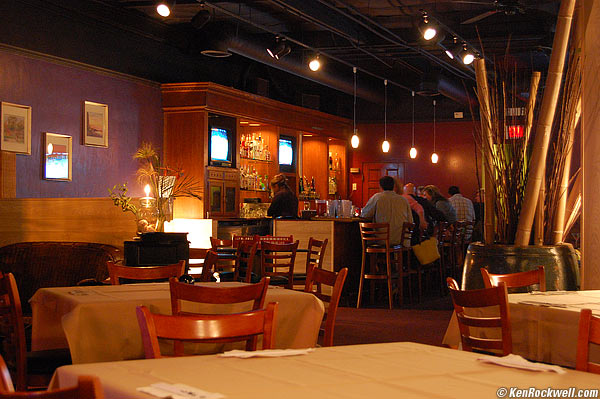
Sushi, Encinitas, California.
D40, 18-55mm II kit lens @ 42mm, f/5.3 @ 1/3, ISO AUTO (1,600), AUTO White Balance, hand held (elbows on table, good manners for photography). You read it right: it's sharp at 1/3 second, not 1/30. I'm impressed at how easy it is for me to get solid shots at slow speeds with the D40; it's so light and has so little vibration it's quite amazing.
That's not noise on the purple wall to the left; it's a textured finish. The restaurant was empty, and after eating there, we know why. We tried it because we had a coupon. The colors look great for leaving WB at auto. I set saturation to + the first time I turned it on, my personal default on Nikons. Color mode, unlike my other Nikons, defaults to IIIa, the more vivid version I prefer, in the D40.
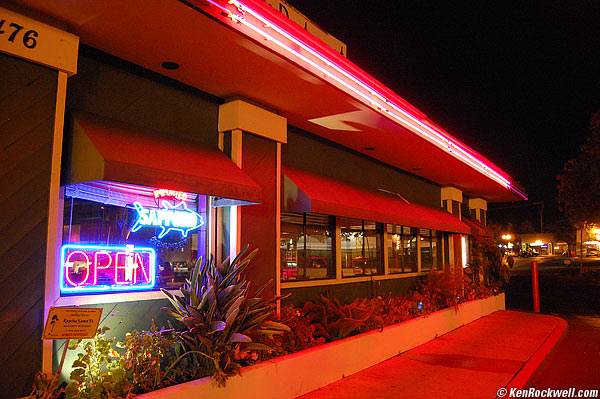
Sushi, Encinitas, California.
D40, 18-55mm II kit lens @ 18mm, f/3.5 @ 1/10, ISO AUTO (1,600), AUTO White Balance, hand held.
My wife had to p-- big time, so I had no more time walking from the restaurant to our car for me to make another with less exposure. Other neon shots look great, retain their color and don't blow out like this bad shot did above. Here's just the neon alone from when we walked in.
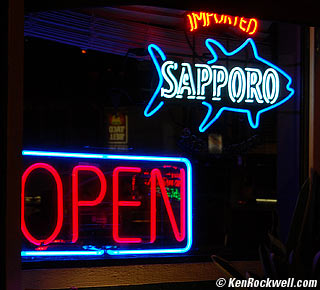
None of these shots has any Photoshop involved except for making them fit your screen. They're exactly as they came from my D40, except I cropped the square neon shot.
Cold Weather: A reader in Minnesota, USA writes that his D40 works perfectly, albeit with a slightly slow-motion LCD, in -15F (-25C) temperatures for at least 30 minutes. He says it sure beats film, which would crack in that cold.
Macro Test with the 18-55mm II kit lens has moved to its own page here.
Dust and Sensor Dirt back to Performance. back to top.
I can't believe some readers: instead of looking at the picture, some people look at the dust. OK, after 15,000 shots and a zillion lens changes there is a speck or two of dust; I find it easier to spot it in Photoshop, if not, I'd suck out my D40 with my Shop-Vac (don't do this yourselves).
Since you people asked, I jammed a Shop-Vac into the lens mount with my D40 open on bulb. So long as I don't suck out my shutter, a distinct possibility, this is all I have to do to clean my sensors:
D40 dust at f/22. Roll mouse over to clean.
Specifications with Commentary
NEXT: >> Recommendations
PLUG
If you find this as helpful as a book you might have had to buy or a workshop you may have had to take, feel free to help me continue helping everyone.
It also helps me keep adding to this site when you get your goodies through these links to Ritz, Amazon and Adorama. I use them and recommend them personally .
Thanks!
Ken
Caveat: The all the ads below come from third parties. I don't see them before they appear on your screen. See more at my Buying Advice page. Personally I get my goodies at Ritz (the store, not the hotel gift shop), Amazon and Adorama.





